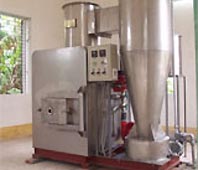Dong Anh Medical Center (Hanoi) discharges 200 m3 of dirty water every day. Number of waste water of the process of examination and treatment of diseases directly flowing into the environment, together with other domestic wastewater. This is normal for district hospitals.

Vietnam does not have many modern medical waste incinerators.(Photo: Vneconomy)
Vietnam currently has approximately 1,050 hospitals, more than 10,000 commune health stations. Together with biomedical research institutes, preventive medicine centers, pharmaceutical manufacturing facilities, they emit huge amounts of medical waste, solid waste has more than 400 tons per year, of which nearly 1 / 10 is dangerous.
The Ministry of Health said only one-third of medical solid waste is burned with a modern oven. The rest were burned outside, burned by manual furnaces, buried in hospital grounds or discharged to a common landfill.
Mr. Nguyen Khac Hai, Director of the Institute of Occupational Medicine and Environmental Hygiene commented that most of medical solid waste treatment methods are not completely effective. With facilities transporting waste outside hospitals to other places to burn, the risk of spreading pathogens during transport is very high because not many establishments have specialized transport facilities.
There is also a risk of burial (often applied in units that do not have incinerators and large amounts of waste), which may cause water pollution, leading to epidemics. On the other hand, over time, the area of land used for this will be over.
Burning with a furnace is not the perfect solution. Hazardous substances will be greatly reduced during combustion but only if the furnace has an exhaust treatment system, but very few medical waste incinerators in Vietnam actually have this system. So the treatment of this poison generates other poisons, polluting the environment.
Doctor Hoang Duc Te, deputy director of the planning department of Dong Anh District Medical Center, said that due to insufficient funds, the treatment of waste at this 200-bed medical facility is very poorly done. With solid waste, waste is collected daily by the company, but hazardous waste is collected once a week. The reason is that every day there are only 10-20 kg of this kind of garbage, not enough for a car trip. Types of waste are buried tissues and organs.
Liquid waste at Dong Anh Medical Center is discharged into the environment without treatment. The situation at this facility is also common with many other places, because among the 1/3 of hospitals there is a wastewater treatment system in Vietnam, mostly central, provincial and sectoral units, only Very few district hospitals. Even in establishments with a wastewater treatment system, the efficiency is not high due to lack of regular operating budget, or improper operation.
Ninh Binh General Hospital is an example. The waste water treatment system of this facility has two storage tanks for sedimentation. Deputy director Le Huu Quy said, due to insufficient funds to operate regularly, the tank was clogged.
Mr. Quy also said that the hospital has a waste management unit only 3 months ago, which is the Department of Anti-Infection. In the past, the hospital had no staff for garbage, neither had anyone specialized in this field. The work is assigned to the material department, when it is moved to the administrative office.
Like other medical facilities, Ninh Binh General Hospital cannot afford a lot of waste treatment. Overload has made money more stressful. According to Quy, to ensure safe disposal of waste, the hospital needs to spend an additional VND 150-200 million per year for this.
The Ministry of Health is developing a hospital waste management program.The objective of this program is to complete the system of legal documents and implementation guidelines in this area by 2010.After 4 years, all hospitals in Vietnam will have solid and liquid waste treatment systems with appropriate technology.
( Ministry of Health )
Hai Ha

 Green tea cleans teeth better than mouthwash?
Green tea cleans teeth better than mouthwash? Death kiss: This is why you should not let anyone kiss your baby's lips
Death kiss: This is why you should not let anyone kiss your baby's lips What is salmonellosis?
What is salmonellosis? Caution should be exercised when using aloe vera through eating and drinking
Caution should be exercised when using aloe vera through eating and drinking